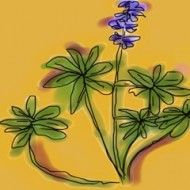The Dry Garden: Pruning sage
Last spring, horticulturist Lili Singer remarked to me that one of the most touching mistakes she sees made by novice dry gardeners is timidity in pruning their sages. And so, in the summer edition of the Theodore Payne Foundation’s Poppy Print newsletter, she nudges native gardening converts to do it.
With thanks to Lili for the push, I am going to echo the prompt in this column in the hope that others may learn to work out their frustrations on their gardens in such a timely fashion.
If it seems late, it isn’t. Only the most ferociously organized gardeners dead-head sage as soon as the flowers fade in June. Watching the flush of flowers drying on the branch through July and August makes for too many sunset grace notes. As Lili notes, birds move in and glean the seeds. Yet by late August, those fluttering elegies to spring just …
The Dry Garden: Vertical waste
Detail of a "Woolly Pocket" (actually recycled plastic) at the SmogShoppe vertical garden in Culver City in summer of 2010. Normally drought tolerant succulents require routine irrigation in a mouldering setting. Photo: Emily Green
They say you catch more flies with honey than vinegar, but I’ve never wanted to catch flies. Moreover, as borrowed phrases go, I far prefer, “If you don’t have anything nice to say, sit by me.” And so, I issued an invitation: If you are skeptical about the vogue for vertical gardens, sit by me.
A few smart people from the worlds of gardening and landscape architecture took the chair. Here’s what they had to say.
Click here to keep reading this week’s ‘Dry Garden’ in the Los Angeles Times.
A comment string to do with this post has been removed because it was overpopulating the home page and descending in tone. The sentiments of the …
The Dry Garden: Past as prologue
The West Adams Heritage Assn. celebrates the preservation of historic houses, but earlier this month, a markedly modern installation in Jefferson Park shared its “best garden” prize. Look at the home of Marina Moevs and Steve Peckman, and it’s obvious why: Few gardens could do a better job accenting but not overwhelming their lovingly restored Craftsman home.
After having taken pains to strip, then stain the clapboard for a weathered, muted effect, the first criterion that Moevs and Peckman put to a local garden designer was to keep the plants low. Herbs would be welcome, but they didn’t want any specimens taller than 3 feet. Furthermore, they didn’t want to water — or at least water often. Finally, they wanted to capitalize on a cash-for-grass program that offers rebates for replacing turf with a low-water alternative.
Click here to keep reading about the Peckman-Moevs project in The Dry Garden in …
The Dry Garden: In praise of Elmer Avenue
For all-around grooviness, a Sun Valley block that two years ago had no sidewalks, no street lights, no storm drains and no curbs should be next spring’s hot ticket on the home-tour circuit. Thanks to a newly completed makeover involving one federal bureau, one state agency, as many as six city agencies, three nonprofit groups and 24 homeowners, Elmer Avenue has become the Rolls-Royce of L.A.’s Green Street initiative.
Click here to keep reading in the Los Angeles Times about how the makeover of one block in the San Fernando Valley has resulted in a mass transition to drought tolerant gardens and the capture of 16 acre feet of storm water a year.…
Changing the equation
Los Angeles garden designer Marilee Kuhlmann was one of eighty homeowners who opened their gardens last weekend for the Mar Vista Green Garden Showcase. Photo: Emily Green / Chance of Rain
In so many conventional gardens with lawn and hedges, the equation is:
Water = sprinkler run-off and plant growth = Pacific pollution and mowing and pruning = noise and air pollution = green waste = more noise and air pollution.
Most of us know how destructive it is but have little idea how to change. Last week, the Mar Vista Green Garden Showcase in Los Angeles set out to show the way. In what felt less like a garden tour and more like a happening, eighty West Los Angeles homeowners who have taken out turf to create gardens that trap rainwater, produce food and have well-adapted flora opened their homes to the public. Here, the new equation is:
Water …
« go back — keep looking »

